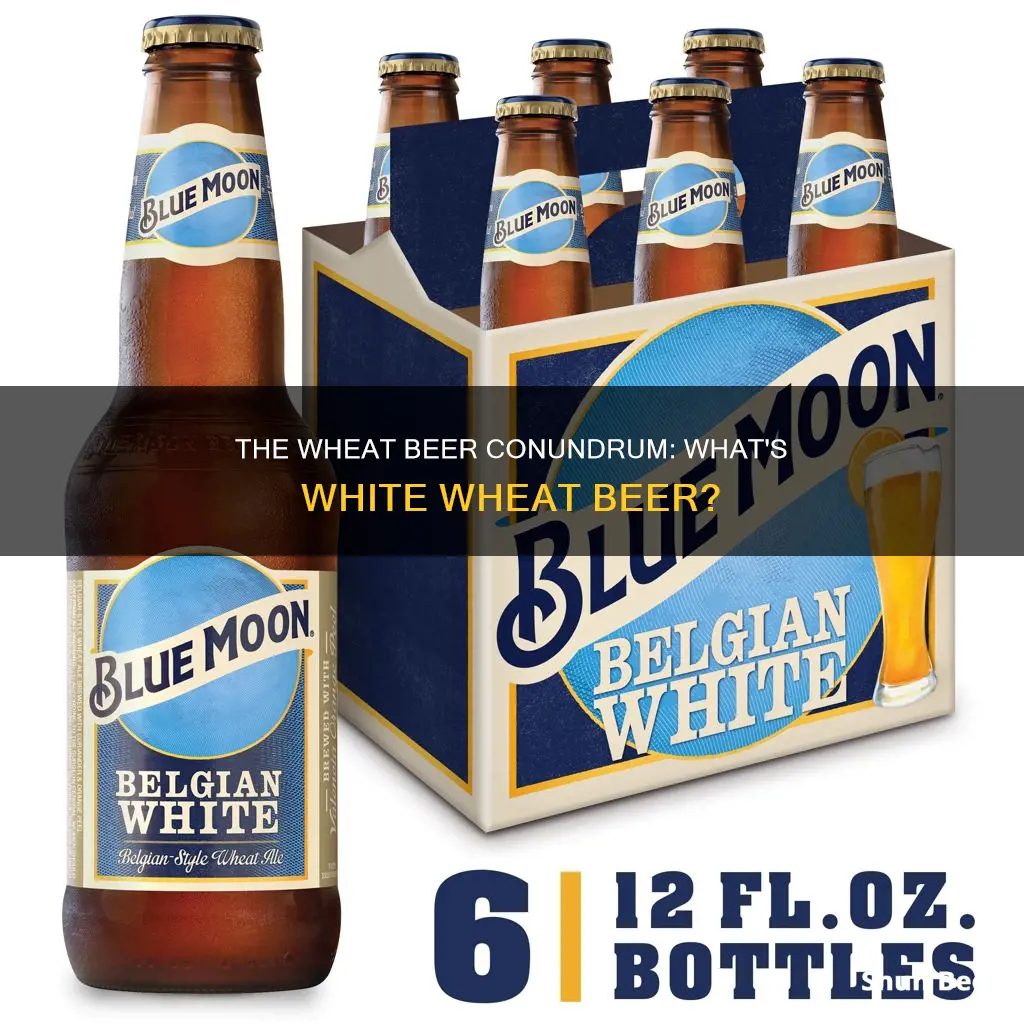
White wheat beer, also known as witbier (Dutch/Flemish for white beer), is a low-alcohol, top-fermented wheat beer that originated in Belgium in the Middle Ages. It is traditionally brewed with unmalted wheat, barley, and spices such as coriander and orange peel, resulting in a refreshing and slightly spicy flavour. Witbiers are characterised by their cloudy, white appearance in a glass, caused by the suspension of yeast and wheat proteins. Unlike German wheat beers, which avoid spices and rely on specific yeasts for flavour, witbiers offer a simple yet flavourful alternative, with a long history.
What You'll Learn

Witbier, or white beer, is a low-alcohol wheat beer
The flavour profile of witbier is characterised by its refreshing and slightly spicy taste, often incorporating coriander and orange peel. The coriander and orange peel are added during the brewing process, along with curaçao peels, which are the peels of a bitter orange. The combination of these ingredients gives witbier its distinctive citrus and spice notes.
Witbier is known for its cloudy appearance, which is caused by the wheat proteins that remain suspended in the liquid. This hazy quality contributes to its name, as the beer appears white or cloudy instead of clear. The haze is also due to the presence of yeast, which remains in suspension after fermentation, adding to the complex flavour and aroma profile of the beer.
The alcohol content of traditional witbier is typically between 4.5% and 5% ABV, making it a perfect choice for enjoying multiple bottles without a heavy alcoholic punch. The gentle flavour of witbier also makes it an excellent pairing with food, especially spicy dishes. The acidity in witbier stands up to bold flavours without overwhelming the taste buds.
Witbier has experienced a revival in recent years, with the Belgian-style witbier, Hoegaarden, leading the way. This popular witbier is named after the town in which it is brewed and has become a well-known example of the style. Another notable witbier is Blue Moon Belgian White, an American interpretation that has gained widespread attention.
Wheat Beer: What Makes Wheat Beer Unique?
You may want to see also

It's traditionally flavoured with orange peel and coriander
Wheat beer, also known as witbier (Dutch for "white beer"), is a top-fermented beer brewed with a large proportion of wheat relative to the amount of malted barley. It is often made with raw unmalted wheat and is known for its cloudy, white appearance. Witbiers are traditionally flavoured with coriander and orange peel, which complement the beer's citrusy and fruity notes.
The addition of coriander and orange peel to witbier is a long-standing tradition, with origins in Belgium and the Netherlands. The spices enhance the beer's flavour and aroma, creating a unique and refreshing drinking experience. Coriander, in particular, is known to impart a floral and citrusy character to the beer. The amount of coriander added can vary depending on the desired intensity of flavour, with some recipes calling for up to 1 ounce of freshly crushed coriander seed.
Orange peel, on the other hand, contributes to the bitterness of the beer and enhances its citrusy notes. Both sweet and bitter orange peel can be used, with some recipes specifying Curacao orange peel. The amount of orange peel added can range from 0.5 to 1.5 ounces, depending on the desired level of citrus character.
The timing of adding the spices is crucial to achieving the desired flavour. Most recipes recommend adding the coriander and orange peel during the last 10 to 15 minutes of the boil. This allows the spices to release their flavours without becoming overwhelming. Some brewers also experiment with adding the spices at different stages, such as during fermentation or in the secondary stage, to create unique flavour profiles.
In addition to coriander and orange peel, witbiers may also include other spices such as peppercorn, ginger, or bitter orange. The flexibility in ingredients and brewing techniques allows brewers to create their own unique variations of this traditional beer style.
Exploring Bock and Wheat Beer Differences
You may want to see also

It's also known as bière blanche in French
Wheat beer is a top-fermented beer brewed with a large proportion of wheat relative to the amount of malted barley. The two main varieties are German Weizenbier and Belgian witbier. Witbier, which translates as "white beer", is a low-alcohol wheat beer. It is also known as bière blanche in French.
Bière blanche, or witbier, is a barley/wheat, top-fermented beer brewed mainly in Belgium and the Netherlands. It gets its name from the suspended yeast and wheat proteins, which cause the beer to look hazy, or white, when cold. Today, along with hops, it usually contains a blend of spices, such as coriander, orange, and bitter orange.
As early as the 16th and 17th centuries, the white beers of Hoegaarden and Leuven were renowned. Along with barley malt and unmalted barley, they contained some oats, though apart from hops, no other spices were used. The barley was usually not kilned but left to dry in attics where the wind was allowed to blow past it, in order to obtain a light colour.
The style was revived by Pierre Celis at the Hoegaarden Brewery in Belgium and the Celis Brewery in the United States. It is traditionally made with up to 50% raw wheat rather than wheat malt. It was probably Celis who started adding the various spices. The beers have a somewhat sour taste due to the presence of lactic acid or acetic acid, much more pronounced in the past than today. Also, the suspended yeast in the beer causes some continuing fermentation in the bottle.
Malt Beer and Wheat: What's the Connection?
You may want to see also

German wheat beer differs from Belgian white beer in terms of ingredients
Wheat beer is a top-fermented beer brewed with a large proportion of wheat relative to the amount of malted barley. The two main varieties are German Weizenbier (or Hefeweizen) and Belgian Witbier.
German wheat beer, or Weißbier, uses at least 52% wheat to barley malt, resulting in a light-coloured beer. It is brewed with special weizen yeast, which gives off characteristic clove and banana flavours. By law, Weißbiers brewed in Germany must use a "top-fermenting" yeast. The soft, sweet, fruity character of the beer comes solely from the yeast. German wheat beer complies with the Reinheitsgebot (the German purity law), which forbids any ingredients other than water, barley, and hops.
Belgian white beer, or Witbier, on the other hand, uses unmalted wheat, with the percentage of unmalted grains in the grist approaching 50%, though 30-40% is more common. It is also spiced with coriander and orange peel, resulting in a refreshing and slightly spicy flavour profile. Belgian Witbiers are top-fermented but do not use the same special weizen yeast as German wheat beers, resulting in a different taste profile.
In terms of appearance, German wheat beers tend to be cloudy due to the wheat proteins that can suspend in the liquid, while Belgian Witbiers are known for their cloudy, hazy appearance when cold due to suspended yeast and wheat proteins.
Wheat in Beer: Amberbock's Secret Ingredient?
You may want to see also

Witbiers are best served chilled in a thick and sturdy glass
White wheat beer, or witbier, is a low-alcohol wheat beer that is traditionally flavoured with orange peel and coriander. It is also known as bière blanche in French and wit bier in Flemish. Witbiers are characterised by their cloudy appearance in a glass, with a colour that falls somewhere between a pilsner and a heavy IPA. The alcohol content of traditional white wheat beer is between 4.5% and 5% ABV.
The witbier style of white wheat beer is a top-fermented beer brewed mainly in Belgium and the Netherlands. The name witbier, which translates to "white beer", comes from the suspended yeast and wheat proteins that cause the beer to look hazy or white when cold. In addition to hops, witbiers usually contain a blend of spices such as coriander, orange, and bitter orange.
When it comes to serving witbiers, it is important to use the right glassware. The shape of the glass can impact the head development and retention of the beer, affecting the volatile compounds that create its aroma. For witbiers, a thick and sturdy glass is recommended. This type of glass can help to enhance the aromatic compounds inherent to the beer, improving the drinking experience.
One option for serving witbiers is the pilsner glass, which is tall, slim, and slightly wider at the mouth. This type of glass helps to showcase the sparkle, clarity, and bubbles of the beer, while also retaining the head. Pilsner glasses typically hold between 12 and 14 ounces of beer.
Another option is the weizen glass, which is specifically designed for wheat beers. The weizen glass has thin walls and a lot of length to showcase the colour of the beer. It also provides space for the thick, fluffy head that is characteristic of witbiers. The weizen glass typically holds about 500 ml of beer, making it larger than the pilsner glass.
When serving witbiers, it is also important to consider the temperature. Witbiers are best served chilled, as this can help to enhance the flavour and aroma of the beer. Chilling the glassware is not recommended, however, as it can cause condensation that dilutes the beer and alters the serving temperature.
Wheat Beers: Barley's Role Explored
You may want to see also
Frequently asked questions
White wheat beer, or witbier, is an unfiltered, top-fermented wheat beer. It is often spiced with coriander and orange peel, resulting in a refreshing and slightly spicy flavour profile.
German wheat beer, or weissbier, tends to avoid spices and derives most of its flavour from specific yeasts. White wheat beer, on the other hand, includes additional ingredients such as unmalted wheat, oats, and various spices.
White wheat beer, or witbier, originated in the Middle Ages in Belgium, particularly in the Flemish region, where brewers had access to cereal grains and spices from neighbouring farms and the Netherlands.
White wheat beer is made with a combination of unmalted wheat, barley, and sometimes oats. It typically includes spices such as coriander and orange peel, and has a cloudy, hazy appearance due to the suspension of yeast and wheat proteins.
White wheat beer has a refreshing and bright taste, with a balance of citrus and spice notes. It is known for its low bitterness and light, crisp nature, making it a perfect summer drink.







